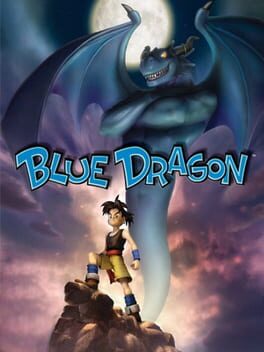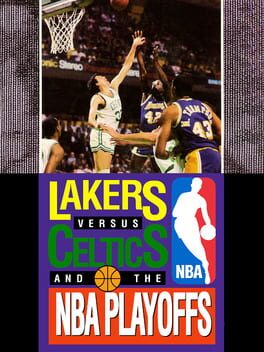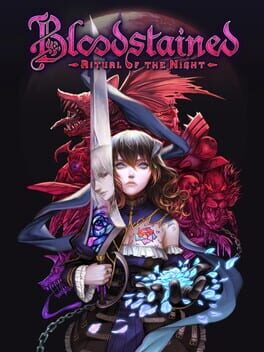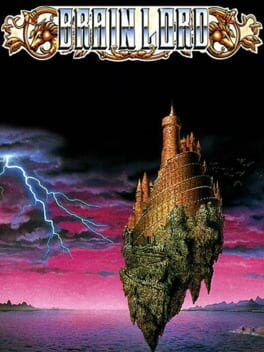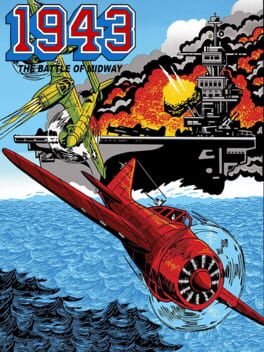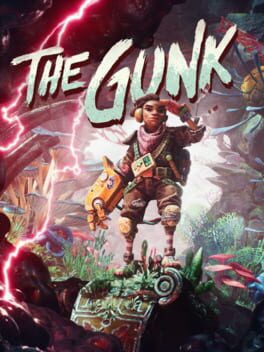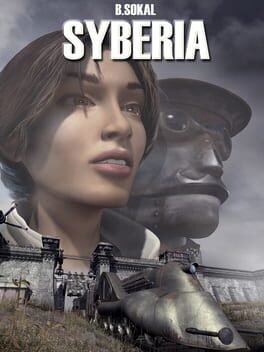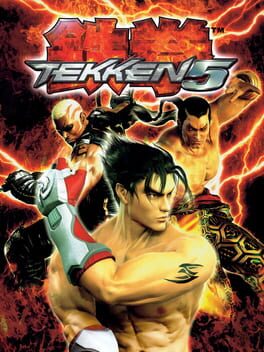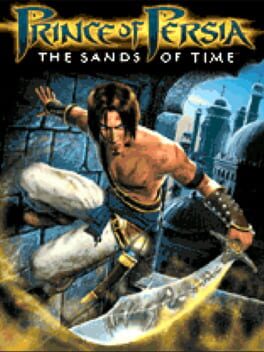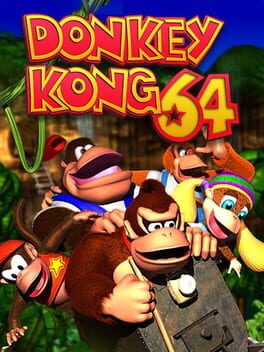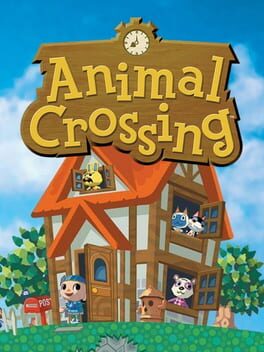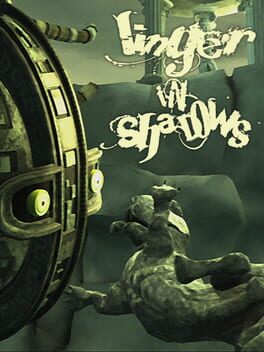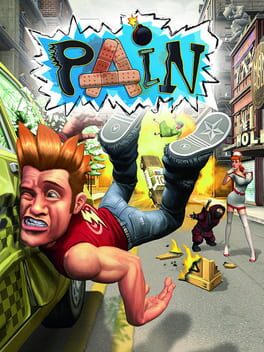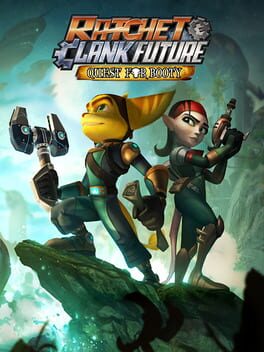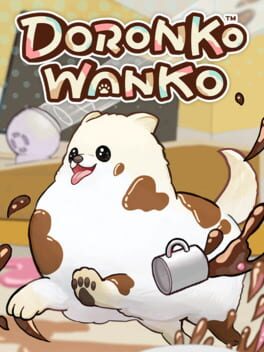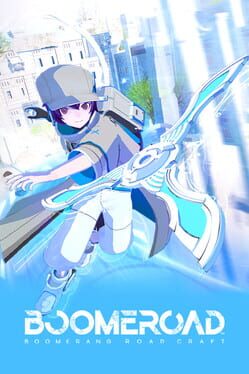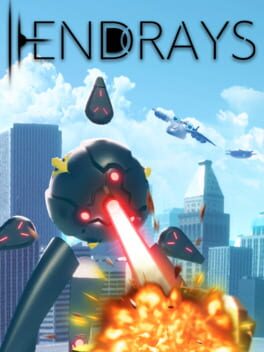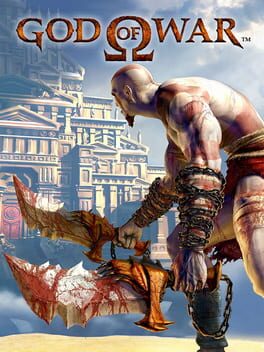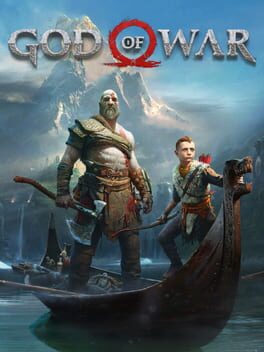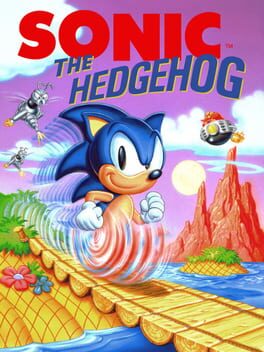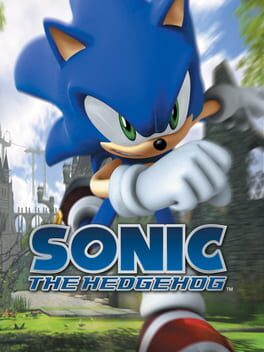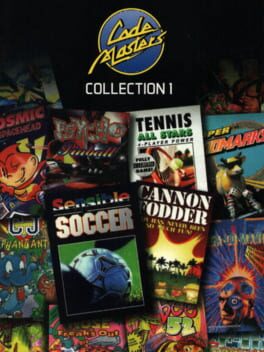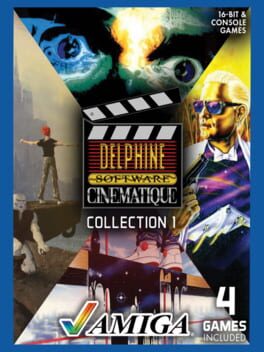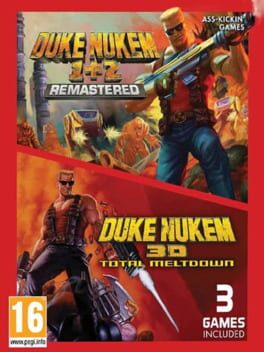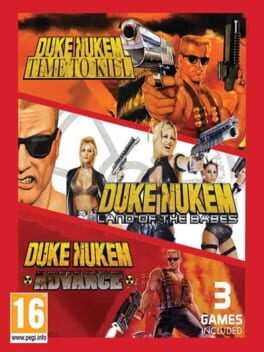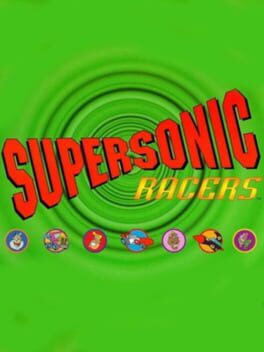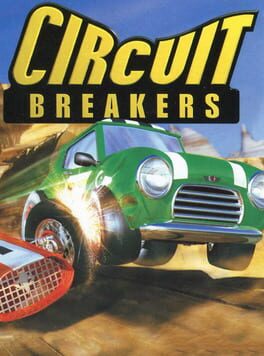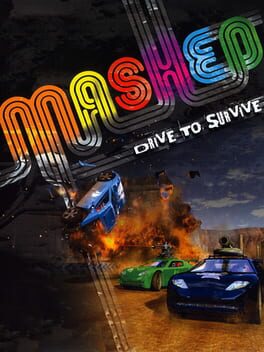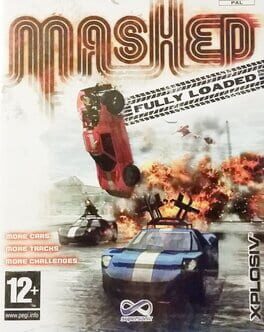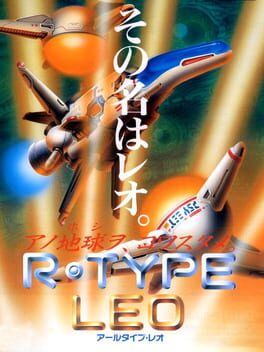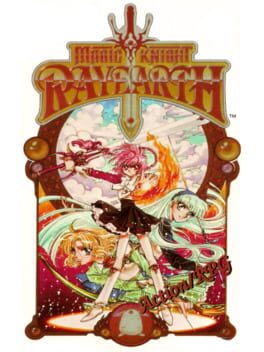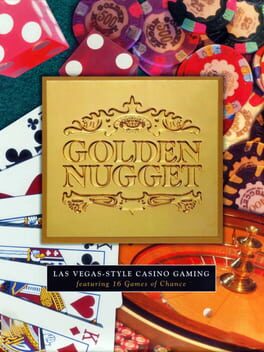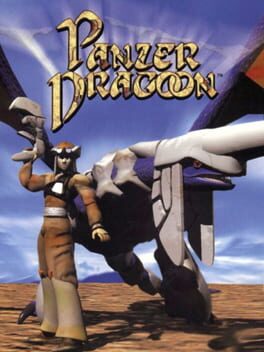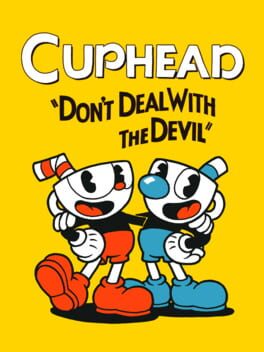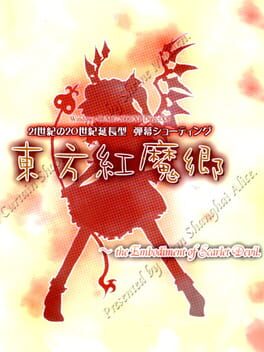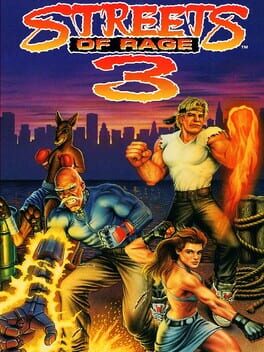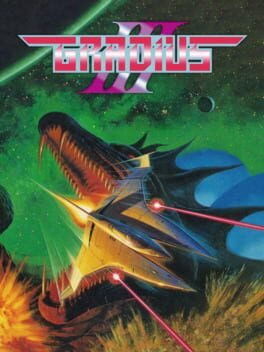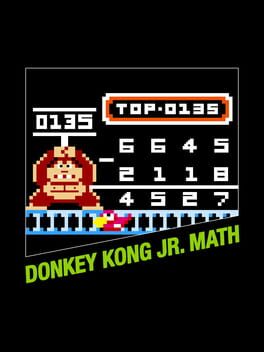letshugbro
4375 reviews liked by letshugbro
Buddy, I've not had a love/hate relationship like this in a minute......
There's so so much I want to write about but I don't want to make myself all mad/sad.
Yeah, I mighta had a better time if I didn't pour 100 hours into it going over all the side content but that shouldn't be on me?
Gears and Gambits? Gears and Get To Fuck.
See you in 4 years or whatever
There's so so much I want to write about but I don't want to make myself all mad/sad.
Yeah, I mighta had a better time if I didn't pour 100 hours into it going over all the side content but that shouldn't be on me?
Gears and Gambits? Gears and Get To Fuck.
See you in 4 years or whatever
Resident Evil 4
2005
"They always feel new - constant, but constantly surprising. They become part of your private autobiography and every time you [play] them a new layer of memory is added to the bond between you. Each performance is a collection of the experiences you have had together. Not many friendships last so long - I suppose the unchanging nature of the music simplifies the dynamic between you - but what would be an unhealthily one-sided affair in your personal life provides a great deal of comfort throughout your professional one. It is even richer if you can always remember the initial naivety, wonder, and thrill that accompanied your first 'date'."
This is a quote from an orchestral conductor about his evolving relationship with great pieces of classical music, but I suspect it's pretty easy for many of us to substitute a couple of words and apply it directly to our experiences with our favorite games. And in the case of RE4 it was a first date to remember.
It was the late spring of 2005, my friend had just bought the game, eight of us crammed into his dorm room at midnight, turned the lights out and the volume up as we played through the first 3 chapters more or less blind. The idea was that we'd pass the controller around whenever the player died, but the first guy somehow stayed alive all the way until chapter 3-2! Us seven spectators had one of the most intense watch-sessions ever, alternating between "AHHHH!" and "EWWWW" and "LOLOL Chuck Norris roundhouse kicks".
Two years later, I bought the Wii version - now I could shoot a Ganado in the leg and then in the face a split second later! It was so damn addictive that I completed the game (for the first time) in one single 16-hour sitting. A friend picked me up to go to a party right after, and I spent the entire time in a hazy half-asleep stupor hovering between RE4 and reality. And while I don't remember this, he said (while laughing his ass off) that at one point I stood in front of a vase and swiped my right arm back and forth in the "break vase" Wiimote gesture for a few seconds.
I've returned to Resident Evil 4 at so many different seasons of my life - playing quick rounds of Mercenaries mode with a warm bottle of milk in my lap waiting for my infant daughter to start fussing, doing a handgun-only pro run when COVID lockdowns first started - that it has to be a five-star game for me. It's not just that I have plenty of memories of it; it's that the game was addictive and fantastic enough that I kept coming back to it to make those memories in the first place, and that's something that no amount of plot contrivances or anticlimactic final acts can take away from it.
Plenty of reviews have waxed lyrical on this game's virtues better than I can, but I wanted to point out how impressed I am with how the iconic village brawl really teaches the new player how to play the game. It establishes from the outset that unlike the zombies from previous games, these guys are capable of running, moving intelligently to flank you, and following you up stairs and through windows. And through a mix of its large enemy swarms, the presence of sloping terrain which means that you will eventually hit an enemy in the face even if you just spray and pray, and the fact that enemies sometimes stagger forwards when hit in the face, and you've created the conditions for even a complete newbie to discover the melee options by accident. And the melee options are part of the extraordinarily robust but viscerally simple gameplay loop that has sustained my interest in this game through countless playthroughs.
I know that this represents the start of the shift away from survival horror that culminated in the all-action RE6 (that's a review I'm kinda dreading to get to) - but taken as it is it's a blockbuster in all the right ways. It looks and sounds fantastic even today, is exceptionally refined in execution, is a bundle of scares on the first run and then unadulterated fun on subsequent playthroughs, and... it's just good, man. Play it!
This is a quote from an orchestral conductor about his evolving relationship with great pieces of classical music, but I suspect it's pretty easy for many of us to substitute a couple of words and apply it directly to our experiences with our favorite games. And in the case of RE4 it was a first date to remember.
It was the late spring of 2005, my friend had just bought the game, eight of us crammed into his dorm room at midnight, turned the lights out and the volume up as we played through the first 3 chapters more or less blind. The idea was that we'd pass the controller around whenever the player died, but the first guy somehow stayed alive all the way until chapter 3-2! Us seven spectators had one of the most intense watch-sessions ever, alternating between "AHHHH!" and "EWWWW" and "LOLOL Chuck Norris roundhouse kicks".
Two years later, I bought the Wii version - now I could shoot a Ganado in the leg and then in the face a split second later! It was so damn addictive that I completed the game (for the first time) in one single 16-hour sitting. A friend picked me up to go to a party right after, and I spent the entire time in a hazy half-asleep stupor hovering between RE4 and reality. And while I don't remember this, he said (while laughing his ass off) that at one point I stood in front of a vase and swiped my right arm back and forth in the "break vase" Wiimote gesture for a few seconds.
I've returned to Resident Evil 4 at so many different seasons of my life - playing quick rounds of Mercenaries mode with a warm bottle of milk in my lap waiting for my infant daughter to start fussing, doing a handgun-only pro run when COVID lockdowns first started - that it has to be a five-star game for me. It's not just that I have plenty of memories of it; it's that the game was addictive and fantastic enough that I kept coming back to it to make those memories in the first place, and that's something that no amount of plot contrivances or anticlimactic final acts can take away from it.
Plenty of reviews have waxed lyrical on this game's virtues better than I can, but I wanted to point out how impressed I am with how the iconic village brawl really teaches the new player how to play the game. It establishes from the outset that unlike the zombies from previous games, these guys are capable of running, moving intelligently to flank you, and following you up stairs and through windows. And through a mix of its large enemy swarms, the presence of sloping terrain which means that you will eventually hit an enemy in the face even if you just spray and pray, and the fact that enemies sometimes stagger forwards when hit in the face, and you've created the conditions for even a complete newbie to discover the melee options by accident. And the melee options are part of the extraordinarily robust but viscerally simple gameplay loop that has sustained my interest in this game through countless playthroughs.
I know that this represents the start of the shift away from survival horror that culminated in the all-action RE6 (that's a review I'm kinda dreading to get to) - but taken as it is it's a blockbuster in all the right ways. It looks and sounds fantastic even today, is exceptionally refined in execution, is a bundle of scares on the first run and then unadulterated fun on subsequent playthroughs, and... it's just good, man. Play it!
Silent Hill 2
2001
a word of advice: if you love psychological horror, especially silent hill, YOU NEED TO READ CRIME & PUNISHMENT. i understand how a 600 page book released 150 years ago in a format that doesn't exist anymore can seem off-putting or intimidating; i promise you it hasn't aged a day. crime & punishment can suffocate you with tension and anxiety comparable to any horror movie or game using words alone. the characters are oceans of beauty and flaws that will stick with you forever. without dostoevsky, there would be no shining, there would be no subahibi, and there would be no silent hill. read it and thank me later.
Blue Dragon
2006
text by tim rogers
★★★☆
“A BOTTOMLESS BOWL OF CAP'N CRUNCH ON A FIFTY-HOUR SATURDAY MORNING.”
Quite accidentally — that’s how obsessive-compulsize behavior gets started. Case in point: I was eight years old when I first played Dragon Quest, and the game boggled my overweight mind from so many directions — here I’d spent most of my sentient life making Super Mario run and jump, and here was a game that required me to open a menu and click a command to open a door. I needed to sit and review the instruction manual, which I did upon waking early one Saturday morning. I poured a bowl of Cap’n Crunch and read over the instruction manual at my family’s dinner table.
Ever since then, I can’t play a new RPG without reading the instruction manual over a bowl of cold cereal. They used to be big and fascinating. They used to have cryptic, six-to-twelve-page-long story descriptions and tons of character art; Final Fantasy VI for the Super Famicom easily had the best RPG instruction manual of all-time. Most RPGs these days don’t break much new ground in their instruction manuals; part of me wants to groan at every Square-Enix manual, where they will spell everything out in extended notation: “Use the directional buttons up or down to move the cursor up or down; when the cursor has highlighted the ‘Fight’ command, press the O button to confirm.” Namco’s Tales of manuals, on the other hand, are fresh, clean, and honest, three words you’re seldom to hear used about anything made by Namco: they all start with a big chart, in which the directional buttons’ use is described as “On the field: move character” “In menus: move cursor” and the O button is described as “In menus: confirm” “On the field: speak / investigate”. Square-Enix’s games’ manuals earn their lengths by describing the menu selection confirming process every time they explain the function of a different menu selection. Tales of games earn their length and weight when they drift into extended segments about the unique in-game magic systems.
RPG instruction manuals nowadays are rendered unnecessary by droning, in-game tutorials that make sure no newbie is left behind. The manuals continue to exist, it seems, to satisfy the obsessive, now-archetypal desire that sleeps deep within the RPG-playing hordes: the package must be heavy. It must be heavy, and it must be shiny. People like me didn’t use a razor blade to open our Super Nintendo games for nothing: we wanted as much plastic clinging to the package, forever, as possible. This was part of the reason why we balked at Final Fantasy VII‘s being on the PlayStation: because the Nintendo 64 was going to have proper boxes for its games, boxes with plastic wrap, and plenty of room for superfluous maps and posters and posters of maps. Promises of three discs — three ridiculous discs — swayed us, and we stayed when we saw the big instruction manual; years later, with Final Fantasy X, it became dreadfully apparent that DVD cases, made of soft plastic, are lighter than CD jewel cases, and DVDs hold more information, making multi-disc games obsolete; and thus the Heavy-box RPG of yore has faded into the past. People tried to bring it back, by stuffing trinkets and/or soundtrack CDs into the cases, though those people happened to mostly be idiots or, worse, Working Designs.
The Heavy-box RPG has returned to spectacular form, however, with Hironobu Sakaguchi, Mistwalker, and Artoon’s Blue Dragon, which sports a forty-seven-page (not too huge, not too short) glossy instruction manual and a foil-stamped mirror-shiny label (reversible!) over a DVD case that weighs about as much as a loaded laser pistol will weigh in the year 2148. Taped to the outside of the case, when I bought the game back in December of 2006, was a fat, pristine plastic package of stickers to put on anything I wanted, as long as anything I wanted was an Xbox 360 or related peripheral. Breathing through my mouth, I tore open the package, and screamed like a clown on fire when I saw what lay inside: an Xbox-green plastic hinging apparatus, containing one disc on each side, and then a third disc sitting on a spindle inside the back of the case. Three discs! Why hadn’t I, in all my obsessive, news-combing, information-gathering frenzy, known that this game was three discs? Why hadn’t Microsoft advertised such a fact? I suppose game companies aren’t proud of three discs, or of heavy boxes, anymore. It’s something to reflect on that a country like Japan is able to produce values of this caliber, when they’ve gone out of their way to reject value in all other forms; a six-pack of beer, here, is precisely the price of six cans of beer, plus ten extra yen for the package.
Hironobu Sakaguchi saw a grand vision; it told him to get together the most talented artists, programmers, game designers, writers, and musicians, and throw them at several videogames until he had successfully defeated his former home of Square-Enix. In minds as idealistic and pure-hearted as Sakaguchi’s, there’s no way this plan could fail: if you’re able to think on his wavelength there’s no way his RPG Lost Odyssey, featuring the art of Takehiko Inoue and a story by Kiyoshi Shigematsu — both immense talents from outside the videogame industry — will not be awesome. However, this corner of the industry is currently in a stinking state of inbreeding; the first young man in line to purchase Final Fantasy XII, when allowed to ask a question of Square-Enix president Yoichi Wada before a television audience, meekly spoke “Please remake Final Fantasy VII for the PlayStation 3 thank you” and shuffled away. The people like Tetsuya Nomura; they don’t care that he got started as a one-bit pixel-chopper in the Super Famicom days, or that his art style has slowly fluctuated from idiocy to madness. As far as the hardest-cored RPG fans are concerned, Nomura is one of them. Never mind that the first RPGs in the legacy of Japanese RPGs were made by bold, daring people on risk-taking budgets, pouring more money into the pockets of an artist who ended up only ever drawing a couple of shots for the instruction manual than they would pay the programmers. Yuji Horii scored white-hot manga artist Akira Toriyama for Dragon Quest back in 1986, and the move helped the game sell millions. Sakaguchi, meanwhile, in building his counter-Dragon Quest, sought out semi-fine artist Yostuffaka Amano to lend a lofty air to Final Fantasy.
Since those two series exploded all over the world, kids with access to pens and pencils have sought to be as awesome as their idols, and this has resulted in many a Japanese elementary schoolchild telling his teacher he longed to design characters for RPGs when he grew up. What kids are doing, with their cute little dreams, is cutting out the middleman — which, in this case, happens to be “Earn recognition outside the field of videogames before being asked to collaborate on a videogame” — and the videogame industry has never stopped to slap them and tell them to eat their vegetables. Is this a bad thing? Maybe not! I’m certainly not one to judge people provably more successful than me (I’ve never designed characters for a major videogame, et cetera), though certainly, the quality is growing me-too-ish and even dull. Namco’s Tales of games are an ironically good example of uneven distribution of talent. They’ll get a hot rock band like Bump of Chicken to do the theme song, and then let said theme song play out over an animated scene of ferocious vapidity: the camera pans slowly toward each character as they stand perfectly still, and then, just as the camera stops, the character makes some crudely vague gesture with their weapon or magical pet. Sakaguchi must have seen this tsunami coming from miles away. He apparently wanted no part of Final Fantasy VII because he thought the technology wasn’t up to the vision yet. He wanted to keep making games on Nintendo systems, with sprite graphics, while the other half of his team worked squeaked out FMV-laden adventures. When Square subsequently got huge, he probably entertained the idea of sacking Nomura and using the Huge Revenues to hire an awesome artist, like Kentarou Miura, artist of the manga Berserk, which had inspired both the story and the character designs for Final Fantasy VII. He knew from the start that he wouldn’t be able to do this, though; the managers around him were growing increasingly hard-headed, and success would only make their heads harder, and their souls paranoid as hell. Sakaguchi knew that with great power came great potential to piss off one’s fans, and he knew that RPG fans were, more than anything else, fans of the package: if someone likes Final Fantasy VII, then they are fans of Nobuo Uematsu’s music, and of Tetsuya Nomura’s characters. The managers would have considered swapping in a new artist to be like admitting that the previous one hadn’t quite been exactly all that he could have been. It would have been like confessing to a lapse in judgment. It would have been flipping off the fans. To exist in the world, for an artist, is to have fans. Sakaguchi probably knew all these things, and he would have rather loved for Squaresoft to die in loud obscurity.
Even if that had happened — and even though it didn’t — I’ll tell you what that all makes Sakaguchi: it makes him a man. A trooper. He’s wanted little else than to stick to his guns. Even his majorly unsuccessful film debut, “Final Fantasy: The Spirits Within”, while bland, was the work of a man: it wanted nothing more than to push an envelope, and whether you liked it or not (hint: I didn’t), even if the people’s faces were creepy and surreal, it’s just not kosher to diss Sakaguchi about it, when you consider that he was the first to attempt to make a feature-length computer-animated motion picture about realistic-looking human beings, and that no one’s tried such a feat since.
You have to wonder, though, playing Blue Dragon: would Sakaguchi have stayed a film director for life, had “The Spirits Within” been popular? It was well-made enough, and it was even critically acclaimed. Had it set the world on fire, would Sakaguchi still be a film director today? Blue Dragon leaves one with the distinct impression of “maybe”, and that either way, Sakaguchi truly possesses more of the love-like attention to detail necessary to craft a videogame world than any RPG producer outside of Yuji Horii. Sakaguchi said in an interview prior to Blue Dragon‘s release that he wanted to stick with what he knew, with the field and the format he spent years working in, that of the Japanese RPG. After leading the Final Fantasy series slowly down a flaming corridor from utter normalcy to complete nonsense, after spending more time reinventing himself than he ever spent being himself, Sakaguchi has finally settled down, given in, and admitted that there is something he can do better than he can do anything else. Back in the old days, it was a pissing contest, Hironobu Sakaguchi versus Yuji Horii, Final Fantasy versus Dragon Quest, Relentless Reinvention versus Astute Revision. A few hours of Blue Dragon is enough to sound the gong: the war is over, Yuji Horii kind of won, and Hironobu Sakaguchi wears his fatalism pretty well.
If you’ve never played a Japanese RPG before, or if you hate them, or especially if you despise them, you’re probably just going to sigh a lot at Blue Dragon. If you’ve never played a Japanese RPG, at least, you might be able to really get into the game. It’s as good a first RPG as any, and it’s a better one than most. Though if you hate the genre, be not fooled by the precious, amazing graphics. It’s the same old-school game, the same old-school story progressions, the same old-school focus on numbers that go up and hit points that go down. In design, it’s far more reined-in and focused than perhaps any Japanese RPG has ever been, though if you don’t like these games, you’re not going to like this one. If you’ve played dozens of these games and ever loved one of them while hating a couple other ones, chances are you’ll be able to play Blue Dragon, like it a fair deal, and shrug at the end and kind of feel like you’re qualified to judge it as superiorly well-made. Just don’t walk in expecting it to find your hecking car keys and/or change peanut butter into jelly.
There’s certainly a fine-wine quality about this game. Akira Toriyama’s character designs are subtle — the most amazing hairstyle is a pretty average shaggy ponytail — darker, and less fantastic than something he’d submit for Dragon Quest, though if you’ve ever appreciated his work, you’ll no doubt consider these designs sublime. Likewise, Nobuo Uematsu’s musical compositions, while lacking the chintzy flourishes and brassy motifs of his celebrated Final Fantasy VI soundtrack, are rounder and far more musician-like than anything he’s ever composed. Some tracks even approach a Kenji-Ito-like level of pop-song-esque fullness; when Ito makes such music, it tends to stand out so strongly that it distracts from the game, so that the graphics become a background for the music. Uematsu’s score is just subtle enough to fit in, and just catchy enough to make buyers of the soundtrack scratch their heads and wonder why it’s not a little more catchy. And Hironobu Sakaguchi’s scenario is a thing of beauty. After ripping through literally a dozen Tales of games over the years (such was my hunger for scenario-heavy entertainment-focused RPGs), it’s revealing how effortlessly Sakaguchi manages to make “Go to the castle to speak to the king” seem like something legendary heroes really do have to do every other day. Blue Dragon is Sakaguchi blowing steam out of his system; he plays the RPG cliches like a trumpet. Not minutes after we go to a castle to speak with a king, here’s an enemy army invading. Here’s the sky clouded purple. Here’s an opportunity for our heroes to help. The story starts as something of a fractured steampunk yarn, in which our young heroes fight several battles and eventually find themselves aboard a giant flying fortress.
We get to know the characters as they journey back home, and shortly after they discover their purpose — after about fifteen hours of action-packed wandering — the game does something of a snickering little 180. It’s as though, suddenly, the game is now in color, even though it hadn’t quite been in black and white before. It’s something of a low-key “Wizard of Oz”, then. Beyond all expectations, there’s a point where, suddenly, the gorgeous graphics become infinitely more gorgeous, where the lazy threads of the story suddenly and fiercely tie themselves tight together, and the game straightens up and begins, finally, to gain momentum. This is fascinating among modern RPGs, where the plot usually starts hot and heavy, and then gradually loses steam. In Blue Dragon, you’re plinking around dungeons until, at last, the game adopts something of a Chrono Trigger stance, and starts creating elaborate events and set-pieces. More than anything else — even the Active Time Battle system, yes, especially that — this is Sakaguchi’s contribution to the Japanese RPG: where Dragon Quest focused on tricky mazes filled with complex puzzles, Final Fantasy games, as of IV, shifted their focus to short, straightforward, corridor-like dungeons in which dynamic things were happening. A play-through of some of Blue Dragon‘s more complex, domino-like events will perhaps reveal why Sakaguchi is currently so in love with Gears of War: that’s precisely the kind of thing Sakaguchi has always been trying to make, only without the guns, or the action. Sakaguchi’s curb stomps be words.
Once Blue Dragon hits its crescendo, you probably won’t stop playing. Its final act — its third disc — manages to make you actually care about these big-headed kid-like characters (who are all supposed to be sixteen years old, which is kind of creepy, given how tiny their hands are) and what happens to them.
On the whole, it feels like Final Fantasy IV, plot full of gleeful twists and turns. At many points, you can almost imagine the scenario writer snickering as he writes the scene where the characters finally get on a boat and almost instantly get attacked by a sea monster. Every other battle or event in Blue Dragon is like an all-new episode of the only cartoon in the world that could cause you to wake up at eight o’clock on a Saturday morning after a full week of hating elementary school. If there’s anything negative I can say about it, it’s that the beginning part isn’t nearly as much fun as the middle part, though I only noticed that in hindsight: I had been, truthfully, hyperventilating in my excitement to play the game, so I hardly noticed. I had high-definition three-dimensional quasi-realistic super-deformed Akira Toriyama characters before me — the game could have been an interactive paper-doll-dressing simulation, and I would have played it for at least twenty hours.
As I warned earlier, if you hate the genre of Japanese RPG, you won’t like this game. Though if you sincerely like the genre, as far as RPGs go, this one’s pretty great. The battle system is mostly borrowed from Final Fantasy X — an excellent move, as that battle system could benefit from a second chance and some tweaking — though instead of three characters, you have five. Characters’ turns come up based on their agility statistic; you choose an action for them; they execute the action. The similarity to Final Fantasy X‘s battle system is more than skin-deep — it penetrates to the soul. FFX made a ballsy move by eliminating the Active Time Battle system, which is what had differentiated Final Fantasy from Dragon Quest in the first place. The designers of FFX knew that the Active Time Battle system was, effectively, bullstuff. It was a heavy handed and somewhat jack-offish way of making the player feel rushed during battles, though someone, somewhere, must have realized that making players hurry to make menu choices was kind of unnecessarily mean. FFX made the conscientious choice by making the battles truly time-based, tactical contests, rather than forcing players to press buttons and squeal like speds.
The battle system is as stoic as it is frantic. You can see characters’ and enemies’ turns displayed at the top of the screen; highlight an enemy with your attack cursor, and his position in the timeline, also, will be displayed. Use this knowledge to plan your tactics, et cetera. Only FFX kind of flunked out early, by having somewhat tacky disparities: you can only have three party members at a time, and at the start of the game, you basically have one character who can use white magic (for healing), one character who can use black magic (for killing enemies that can only be killed by black magic), one character with an aerial attack (for killing flying enemies), and one character with an armor-piercing attack (for killing armored enemies). This made the battle system kind of cheap: “Oh, there’s a flying enemy — gotta switch in my flying-enemy-killing dude now!” The effect was kind of like walking into an empty room thirty hours into a Zelda game and being asked to light a torch in order to open the door, which you’ve been doing for thirty hecking hours now, even though you’d only ever been playing the game for maybe fifteen minutes.
FFX eventually let you customize your characters, and make them all equal — maybe make them all able to kill flying, piercing, or magical enemies. Blue Dragon, slightly similarly, starts with all of your characters in a gray area. Like in Sakaguchi’s Final Fantasy V, you’re constantly changing the focus of your characters, and hard work (of the level-grinding variety) is rewarded by winning your characters extra, class-specific abilities that can be equipped to any other job class. As you level up your “Black” class, for example, you’ll earn “Black Magic Level 1” or “Level 2” or “Level 3”, allowing you to use different levels of black magic even if you’ve switched back to the “White” class. In this way, you’re mixing and matching your abilities to make “custom” characters — though this isn’t always what makes the battle system interesting. That would be the charge attacks; in any other game using a pseudo-real-time battle system, like Final Fantasy Tactics, magic spells and special attacks carry a basic casting time. Choose to cast a fire spell, and then wait patiently until it’s casted. In Blue Dragon, you can cast any spell or special attack right away — or you can cast it later. It’s all your choice: just after you’ve selected a spell and a target, a charge meter is displayed; the charge meter is marked at the appropriate places with icons representing your fellow party members and the enemy party. Hold down the attack button to charge your attack. Let go when you think you’ve held it down for long enough. At first, it seems like an innocent little tedium-breaker, though it ends up being executed rather brilliantly. Not a third of the way into the game, enemies start showing up who can kill your party members in one violent hit, 100% of the time. You’ll need to hit them before they hit you, while also hitting them hard. A lesser game, like Grandia III, would concentrate your party’s tactics on slowing the enemies down, or canceling their actions. Blue Dragon, on the other hand, forces you to think hard about your own actions. Say you’re fighting an enemy you know to be somewhat vulnerable to paralysis spells. You want to cast a paralysis spell on him, so as to render him immobile for your boys to beat on him for a couple of rounds, and you want to charge the spell up as much as possible — charging increases effectiveness — though you also want the spell to execute before the enemy’s next turn. So you need to think about it for a bit, and you might end up making a compromise that costs one character his (revivable) life. A similar “fine-wine” delicacy creeps into dozens upon dozens of battles throughout the game, and again, if you love these games, it’s a real treat.
There’s a freewheeling, casino-like nature to battling, so that when you win, whatever you get feels like a pay-out. The ability to battle multiple enemy parties at once at first feels kind of a throwaway feature, though it ends up miraculously making grinding more than entertaining for anyone who’s ever played, say, a “Mysterious Dungeon” game. Press the right trigger on the field map to see a list of all the enemies within battling range — choose to fight all of them, and you’ll fight each party, one after another, in sequence. Between enemy parties, a slot machine will pop up on screen, and award you with a bonus: increased strength, speed, et cetera. Interestingly, the only negative effect on the slots is “remove all bonuses”. The game understands, as all Dragon Quest games do, that the game doesn’t lose when players win. It’s already an oath of bravery to take on six enemy parties at once, so the game cuts you a little slack and applauds appropriately when you win.
After more than twenty hours of playing this game, a question popped into my head, and I had to consult the instruction manual. I can’t remember this happening with any other game in the last ten years. My question was about the little red blip on the magic / special attack charge meter. Did I get a bonus if I stopped the bar on that red blip? Or did it do less damage? I honestly couldn’t tell. The instruction manual told me that stopping the bar on the red blip (sometimes very difficult) resulted in the spell doing maximum damage and costing only half as much MP as usual. I felt a little dumb for having not noticed that, though I quickly justified my dumbness by remembering that I’d been avoiding the red blip most of the time because it seldom puts me in a good strategic position. Sometimes the red blip appears at the beginning of the charge bar, sometimes at the end. The battle system kind of starts to philosophically unravel when you realize that a red blip at the beginning is subtly stressing how important it is to attack as quickly as possible and as hard as possible. It’s a slick little quirk, almost worthy of a Romancing SaGa game, though it’s far more philanthropic. Either way, it’s applaudable that the game doesn’t spell this out for you — nor, really, does it spell out anything for you. It expects you to figure things out for yourself, or to read the manual.
That day, I spent an extra twenty minutes or so re-reading the manual. There’s a two-page section at the end, called “Jiro’s tips”, where Jiro, the boy-genius of your party, offers dozens of tips, such as “If the monsters are too strong, try leveling up!” or “You should probably save your game whenever you see a save point!” In the lower-right corner of the second page of the tips section is Maro, the semi-unintelligent, loudmouthed character. He says: “Hey, let me give some tips, too!” and then gives the reader precisely two tips: “Accessories and armor boost your stats” and “Raise your agility statistic to attack more quickly!” Why it has to be Maro giving these two tips, I have no idea. Though I guess that’s the long and short of it, for you. Why bother releasing a Japanese-style RPG, when the genre has been astray so long, and innovated so infrequently, misunderstood by its detractors whenever it does wrong, misunderstood by its fans whenever it tries to reach out? Why step into this minefield, and make another breezy, entertaining game that’s happy not really changing anything? Why, because accessories and armor boost your stats, of course.
★★★☆
“A BOTTOMLESS BOWL OF CAP'N CRUNCH ON A FIFTY-HOUR SATURDAY MORNING.”
Quite accidentally — that’s how obsessive-compulsize behavior gets started. Case in point: I was eight years old when I first played Dragon Quest, and the game boggled my overweight mind from so many directions — here I’d spent most of my sentient life making Super Mario run and jump, and here was a game that required me to open a menu and click a command to open a door. I needed to sit and review the instruction manual, which I did upon waking early one Saturday morning. I poured a bowl of Cap’n Crunch and read over the instruction manual at my family’s dinner table.
Ever since then, I can’t play a new RPG without reading the instruction manual over a bowl of cold cereal. They used to be big and fascinating. They used to have cryptic, six-to-twelve-page-long story descriptions and tons of character art; Final Fantasy VI for the Super Famicom easily had the best RPG instruction manual of all-time. Most RPGs these days don’t break much new ground in their instruction manuals; part of me wants to groan at every Square-Enix manual, where they will spell everything out in extended notation: “Use the directional buttons up or down to move the cursor up or down; when the cursor has highlighted the ‘Fight’ command, press the O button to confirm.” Namco’s Tales of manuals, on the other hand, are fresh, clean, and honest, three words you’re seldom to hear used about anything made by Namco: they all start with a big chart, in which the directional buttons’ use is described as “On the field: move character” “In menus: move cursor” and the O button is described as “In menus: confirm” “On the field: speak / investigate”. Square-Enix’s games’ manuals earn their lengths by describing the menu selection confirming process every time they explain the function of a different menu selection. Tales of games earn their length and weight when they drift into extended segments about the unique in-game magic systems.
RPG instruction manuals nowadays are rendered unnecessary by droning, in-game tutorials that make sure no newbie is left behind. The manuals continue to exist, it seems, to satisfy the obsessive, now-archetypal desire that sleeps deep within the RPG-playing hordes: the package must be heavy. It must be heavy, and it must be shiny. People like me didn’t use a razor blade to open our Super Nintendo games for nothing: we wanted as much plastic clinging to the package, forever, as possible. This was part of the reason why we balked at Final Fantasy VII‘s being on the PlayStation: because the Nintendo 64 was going to have proper boxes for its games, boxes with plastic wrap, and plenty of room for superfluous maps and posters and posters of maps. Promises of three discs — three ridiculous discs — swayed us, and we stayed when we saw the big instruction manual; years later, with Final Fantasy X, it became dreadfully apparent that DVD cases, made of soft plastic, are lighter than CD jewel cases, and DVDs hold more information, making multi-disc games obsolete; and thus the Heavy-box RPG of yore has faded into the past. People tried to bring it back, by stuffing trinkets and/or soundtrack CDs into the cases, though those people happened to mostly be idiots or, worse, Working Designs.
The Heavy-box RPG has returned to spectacular form, however, with Hironobu Sakaguchi, Mistwalker, and Artoon’s Blue Dragon, which sports a forty-seven-page (not too huge, not too short) glossy instruction manual and a foil-stamped mirror-shiny label (reversible!) over a DVD case that weighs about as much as a loaded laser pistol will weigh in the year 2148. Taped to the outside of the case, when I bought the game back in December of 2006, was a fat, pristine plastic package of stickers to put on anything I wanted, as long as anything I wanted was an Xbox 360 or related peripheral. Breathing through my mouth, I tore open the package, and screamed like a clown on fire when I saw what lay inside: an Xbox-green plastic hinging apparatus, containing one disc on each side, and then a third disc sitting on a spindle inside the back of the case. Three discs! Why hadn’t I, in all my obsessive, news-combing, information-gathering frenzy, known that this game was three discs? Why hadn’t Microsoft advertised such a fact? I suppose game companies aren’t proud of three discs, or of heavy boxes, anymore. It’s something to reflect on that a country like Japan is able to produce values of this caliber, when they’ve gone out of their way to reject value in all other forms; a six-pack of beer, here, is precisely the price of six cans of beer, plus ten extra yen for the package.
Hironobu Sakaguchi saw a grand vision; it told him to get together the most talented artists, programmers, game designers, writers, and musicians, and throw them at several videogames until he had successfully defeated his former home of Square-Enix. In minds as idealistic and pure-hearted as Sakaguchi’s, there’s no way this plan could fail: if you’re able to think on his wavelength there’s no way his RPG Lost Odyssey, featuring the art of Takehiko Inoue and a story by Kiyoshi Shigematsu — both immense talents from outside the videogame industry — will not be awesome. However, this corner of the industry is currently in a stinking state of inbreeding; the first young man in line to purchase Final Fantasy XII, when allowed to ask a question of Square-Enix president Yoichi Wada before a television audience, meekly spoke “Please remake Final Fantasy VII for the PlayStation 3 thank you” and shuffled away. The people like Tetsuya Nomura; they don’t care that he got started as a one-bit pixel-chopper in the Super Famicom days, or that his art style has slowly fluctuated from idiocy to madness. As far as the hardest-cored RPG fans are concerned, Nomura is one of them. Never mind that the first RPGs in the legacy of Japanese RPGs were made by bold, daring people on risk-taking budgets, pouring more money into the pockets of an artist who ended up only ever drawing a couple of shots for the instruction manual than they would pay the programmers. Yuji Horii scored white-hot manga artist Akira Toriyama for Dragon Quest back in 1986, and the move helped the game sell millions. Sakaguchi, meanwhile, in building his counter-Dragon Quest, sought out semi-fine artist Yostuffaka Amano to lend a lofty air to Final Fantasy.
Since those two series exploded all over the world, kids with access to pens and pencils have sought to be as awesome as their idols, and this has resulted in many a Japanese elementary schoolchild telling his teacher he longed to design characters for RPGs when he grew up. What kids are doing, with their cute little dreams, is cutting out the middleman — which, in this case, happens to be “Earn recognition outside the field of videogames before being asked to collaborate on a videogame” — and the videogame industry has never stopped to slap them and tell them to eat their vegetables. Is this a bad thing? Maybe not! I’m certainly not one to judge people provably more successful than me (I’ve never designed characters for a major videogame, et cetera), though certainly, the quality is growing me-too-ish and even dull. Namco’s Tales of games are an ironically good example of uneven distribution of talent. They’ll get a hot rock band like Bump of Chicken to do the theme song, and then let said theme song play out over an animated scene of ferocious vapidity: the camera pans slowly toward each character as they stand perfectly still, and then, just as the camera stops, the character makes some crudely vague gesture with their weapon or magical pet. Sakaguchi must have seen this tsunami coming from miles away. He apparently wanted no part of Final Fantasy VII because he thought the technology wasn’t up to the vision yet. He wanted to keep making games on Nintendo systems, with sprite graphics, while the other half of his team worked squeaked out FMV-laden adventures. When Square subsequently got huge, he probably entertained the idea of sacking Nomura and using the Huge Revenues to hire an awesome artist, like Kentarou Miura, artist of the manga Berserk, which had inspired both the story and the character designs for Final Fantasy VII. He knew from the start that he wouldn’t be able to do this, though; the managers around him were growing increasingly hard-headed, and success would only make their heads harder, and their souls paranoid as hell. Sakaguchi knew that with great power came great potential to piss off one’s fans, and he knew that RPG fans were, more than anything else, fans of the package: if someone likes Final Fantasy VII, then they are fans of Nobuo Uematsu’s music, and of Tetsuya Nomura’s characters. The managers would have considered swapping in a new artist to be like admitting that the previous one hadn’t quite been exactly all that he could have been. It would have been like confessing to a lapse in judgment. It would have been flipping off the fans. To exist in the world, for an artist, is to have fans. Sakaguchi probably knew all these things, and he would have rather loved for Squaresoft to die in loud obscurity.
Even if that had happened — and even though it didn’t — I’ll tell you what that all makes Sakaguchi: it makes him a man. A trooper. He’s wanted little else than to stick to his guns. Even his majorly unsuccessful film debut, “Final Fantasy: The Spirits Within”, while bland, was the work of a man: it wanted nothing more than to push an envelope, and whether you liked it or not (hint: I didn’t), even if the people’s faces were creepy and surreal, it’s just not kosher to diss Sakaguchi about it, when you consider that he was the first to attempt to make a feature-length computer-animated motion picture about realistic-looking human beings, and that no one’s tried such a feat since.
You have to wonder, though, playing Blue Dragon: would Sakaguchi have stayed a film director for life, had “The Spirits Within” been popular? It was well-made enough, and it was even critically acclaimed. Had it set the world on fire, would Sakaguchi still be a film director today? Blue Dragon leaves one with the distinct impression of “maybe”, and that either way, Sakaguchi truly possesses more of the love-like attention to detail necessary to craft a videogame world than any RPG producer outside of Yuji Horii. Sakaguchi said in an interview prior to Blue Dragon‘s release that he wanted to stick with what he knew, with the field and the format he spent years working in, that of the Japanese RPG. After leading the Final Fantasy series slowly down a flaming corridor from utter normalcy to complete nonsense, after spending more time reinventing himself than he ever spent being himself, Sakaguchi has finally settled down, given in, and admitted that there is something he can do better than he can do anything else. Back in the old days, it was a pissing contest, Hironobu Sakaguchi versus Yuji Horii, Final Fantasy versus Dragon Quest, Relentless Reinvention versus Astute Revision. A few hours of Blue Dragon is enough to sound the gong: the war is over, Yuji Horii kind of won, and Hironobu Sakaguchi wears his fatalism pretty well.
If you’ve never played a Japanese RPG before, or if you hate them, or especially if you despise them, you’re probably just going to sigh a lot at Blue Dragon. If you’ve never played a Japanese RPG, at least, you might be able to really get into the game. It’s as good a first RPG as any, and it’s a better one than most. Though if you hate the genre, be not fooled by the precious, amazing graphics. It’s the same old-school game, the same old-school story progressions, the same old-school focus on numbers that go up and hit points that go down. In design, it’s far more reined-in and focused than perhaps any Japanese RPG has ever been, though if you don’t like these games, you’re not going to like this one. If you’ve played dozens of these games and ever loved one of them while hating a couple other ones, chances are you’ll be able to play Blue Dragon, like it a fair deal, and shrug at the end and kind of feel like you’re qualified to judge it as superiorly well-made. Just don’t walk in expecting it to find your hecking car keys and/or change peanut butter into jelly.
There’s certainly a fine-wine quality about this game. Akira Toriyama’s character designs are subtle — the most amazing hairstyle is a pretty average shaggy ponytail — darker, and less fantastic than something he’d submit for Dragon Quest, though if you’ve ever appreciated his work, you’ll no doubt consider these designs sublime. Likewise, Nobuo Uematsu’s musical compositions, while lacking the chintzy flourishes and brassy motifs of his celebrated Final Fantasy VI soundtrack, are rounder and far more musician-like than anything he’s ever composed. Some tracks even approach a Kenji-Ito-like level of pop-song-esque fullness; when Ito makes such music, it tends to stand out so strongly that it distracts from the game, so that the graphics become a background for the music. Uematsu’s score is just subtle enough to fit in, and just catchy enough to make buyers of the soundtrack scratch their heads and wonder why it’s not a little more catchy. And Hironobu Sakaguchi’s scenario is a thing of beauty. After ripping through literally a dozen Tales of games over the years (such was my hunger for scenario-heavy entertainment-focused RPGs), it’s revealing how effortlessly Sakaguchi manages to make “Go to the castle to speak to the king” seem like something legendary heroes really do have to do every other day. Blue Dragon is Sakaguchi blowing steam out of his system; he plays the RPG cliches like a trumpet. Not minutes after we go to a castle to speak with a king, here’s an enemy army invading. Here’s the sky clouded purple. Here’s an opportunity for our heroes to help. The story starts as something of a fractured steampunk yarn, in which our young heroes fight several battles and eventually find themselves aboard a giant flying fortress.
We get to know the characters as they journey back home, and shortly after they discover their purpose — after about fifteen hours of action-packed wandering — the game does something of a snickering little 180. It’s as though, suddenly, the game is now in color, even though it hadn’t quite been in black and white before. It’s something of a low-key “Wizard of Oz”, then. Beyond all expectations, there’s a point where, suddenly, the gorgeous graphics become infinitely more gorgeous, where the lazy threads of the story suddenly and fiercely tie themselves tight together, and the game straightens up and begins, finally, to gain momentum. This is fascinating among modern RPGs, where the plot usually starts hot and heavy, and then gradually loses steam. In Blue Dragon, you’re plinking around dungeons until, at last, the game adopts something of a Chrono Trigger stance, and starts creating elaborate events and set-pieces. More than anything else — even the Active Time Battle system, yes, especially that — this is Sakaguchi’s contribution to the Japanese RPG: where Dragon Quest focused on tricky mazes filled with complex puzzles, Final Fantasy games, as of IV, shifted their focus to short, straightforward, corridor-like dungeons in which dynamic things were happening. A play-through of some of Blue Dragon‘s more complex, domino-like events will perhaps reveal why Sakaguchi is currently so in love with Gears of War: that’s precisely the kind of thing Sakaguchi has always been trying to make, only without the guns, or the action. Sakaguchi’s curb stomps be words.
Once Blue Dragon hits its crescendo, you probably won’t stop playing. Its final act — its third disc — manages to make you actually care about these big-headed kid-like characters (who are all supposed to be sixteen years old, which is kind of creepy, given how tiny their hands are) and what happens to them.
On the whole, it feels like Final Fantasy IV, plot full of gleeful twists and turns. At many points, you can almost imagine the scenario writer snickering as he writes the scene where the characters finally get on a boat and almost instantly get attacked by a sea monster. Every other battle or event in Blue Dragon is like an all-new episode of the only cartoon in the world that could cause you to wake up at eight o’clock on a Saturday morning after a full week of hating elementary school. If there’s anything negative I can say about it, it’s that the beginning part isn’t nearly as much fun as the middle part, though I only noticed that in hindsight: I had been, truthfully, hyperventilating in my excitement to play the game, so I hardly noticed. I had high-definition three-dimensional quasi-realistic super-deformed Akira Toriyama characters before me — the game could have been an interactive paper-doll-dressing simulation, and I would have played it for at least twenty hours.
As I warned earlier, if you hate the genre of Japanese RPG, you won’t like this game. Though if you sincerely like the genre, as far as RPGs go, this one’s pretty great. The battle system is mostly borrowed from Final Fantasy X — an excellent move, as that battle system could benefit from a second chance and some tweaking — though instead of three characters, you have five. Characters’ turns come up based on their agility statistic; you choose an action for them; they execute the action. The similarity to Final Fantasy X‘s battle system is more than skin-deep — it penetrates to the soul. FFX made a ballsy move by eliminating the Active Time Battle system, which is what had differentiated Final Fantasy from Dragon Quest in the first place. The designers of FFX knew that the Active Time Battle system was, effectively, bullstuff. It was a heavy handed and somewhat jack-offish way of making the player feel rushed during battles, though someone, somewhere, must have realized that making players hurry to make menu choices was kind of unnecessarily mean. FFX made the conscientious choice by making the battles truly time-based, tactical contests, rather than forcing players to press buttons and squeal like speds.
The battle system is as stoic as it is frantic. You can see characters’ and enemies’ turns displayed at the top of the screen; highlight an enemy with your attack cursor, and his position in the timeline, also, will be displayed. Use this knowledge to plan your tactics, et cetera. Only FFX kind of flunked out early, by having somewhat tacky disparities: you can only have three party members at a time, and at the start of the game, you basically have one character who can use white magic (for healing), one character who can use black magic (for killing enemies that can only be killed by black magic), one character with an aerial attack (for killing flying enemies), and one character with an armor-piercing attack (for killing armored enemies). This made the battle system kind of cheap: “Oh, there’s a flying enemy — gotta switch in my flying-enemy-killing dude now!” The effect was kind of like walking into an empty room thirty hours into a Zelda game and being asked to light a torch in order to open the door, which you’ve been doing for thirty hecking hours now, even though you’d only ever been playing the game for maybe fifteen minutes.
FFX eventually let you customize your characters, and make them all equal — maybe make them all able to kill flying, piercing, or magical enemies. Blue Dragon, slightly similarly, starts with all of your characters in a gray area. Like in Sakaguchi’s Final Fantasy V, you’re constantly changing the focus of your characters, and hard work (of the level-grinding variety) is rewarded by winning your characters extra, class-specific abilities that can be equipped to any other job class. As you level up your “Black” class, for example, you’ll earn “Black Magic Level 1” or “Level 2” or “Level 3”, allowing you to use different levels of black magic even if you’ve switched back to the “White” class. In this way, you’re mixing and matching your abilities to make “custom” characters — though this isn’t always what makes the battle system interesting. That would be the charge attacks; in any other game using a pseudo-real-time battle system, like Final Fantasy Tactics, magic spells and special attacks carry a basic casting time. Choose to cast a fire spell, and then wait patiently until it’s casted. In Blue Dragon, you can cast any spell or special attack right away — or you can cast it later. It’s all your choice: just after you’ve selected a spell and a target, a charge meter is displayed; the charge meter is marked at the appropriate places with icons representing your fellow party members and the enemy party. Hold down the attack button to charge your attack. Let go when you think you’ve held it down for long enough. At first, it seems like an innocent little tedium-breaker, though it ends up being executed rather brilliantly. Not a third of the way into the game, enemies start showing up who can kill your party members in one violent hit, 100% of the time. You’ll need to hit them before they hit you, while also hitting them hard. A lesser game, like Grandia III, would concentrate your party’s tactics on slowing the enemies down, or canceling their actions. Blue Dragon, on the other hand, forces you to think hard about your own actions. Say you’re fighting an enemy you know to be somewhat vulnerable to paralysis spells. You want to cast a paralysis spell on him, so as to render him immobile for your boys to beat on him for a couple of rounds, and you want to charge the spell up as much as possible — charging increases effectiveness — though you also want the spell to execute before the enemy’s next turn. So you need to think about it for a bit, and you might end up making a compromise that costs one character his (revivable) life. A similar “fine-wine” delicacy creeps into dozens upon dozens of battles throughout the game, and again, if you love these games, it’s a real treat.
There’s a freewheeling, casino-like nature to battling, so that when you win, whatever you get feels like a pay-out. The ability to battle multiple enemy parties at once at first feels kind of a throwaway feature, though it ends up miraculously making grinding more than entertaining for anyone who’s ever played, say, a “Mysterious Dungeon” game. Press the right trigger on the field map to see a list of all the enemies within battling range — choose to fight all of them, and you’ll fight each party, one after another, in sequence. Between enemy parties, a slot machine will pop up on screen, and award you with a bonus: increased strength, speed, et cetera. Interestingly, the only negative effect on the slots is “remove all bonuses”. The game understands, as all Dragon Quest games do, that the game doesn’t lose when players win. It’s already an oath of bravery to take on six enemy parties at once, so the game cuts you a little slack and applauds appropriately when you win.
After more than twenty hours of playing this game, a question popped into my head, and I had to consult the instruction manual. I can’t remember this happening with any other game in the last ten years. My question was about the little red blip on the magic / special attack charge meter. Did I get a bonus if I stopped the bar on that red blip? Or did it do less damage? I honestly couldn’t tell. The instruction manual told me that stopping the bar on the red blip (sometimes very difficult) resulted in the spell doing maximum damage and costing only half as much MP as usual. I felt a little dumb for having not noticed that, though I quickly justified my dumbness by remembering that I’d been avoiding the red blip most of the time because it seldom puts me in a good strategic position. Sometimes the red blip appears at the beginning of the charge bar, sometimes at the end. The battle system kind of starts to philosophically unravel when you realize that a red blip at the beginning is subtly stressing how important it is to attack as quickly as possible and as hard as possible. It’s a slick little quirk, almost worthy of a Romancing SaGa game, though it’s far more philanthropic. Either way, it’s applaudable that the game doesn’t spell this out for you — nor, really, does it spell out anything for you. It expects you to figure things out for yourself, or to read the manual.
That day, I spent an extra twenty minutes or so re-reading the manual. There’s a two-page section at the end, called “Jiro’s tips”, where Jiro, the boy-genius of your party, offers dozens of tips, such as “If the monsters are too strong, try leveling up!” or “You should probably save your game whenever you see a save point!” In the lower-right corner of the second page of the tips section is Maro, the semi-unintelligent, loudmouthed character. He says: “Hey, let me give some tips, too!” and then gives the reader precisely two tips: “Accessories and armor boost your stats” and “Raise your agility statistic to attack more quickly!” Why it has to be Maro giving these two tips, I have no idea. Though I guess that’s the long and short of it, for you. Why bother releasing a Japanese-style RPG, when the genre has been astray so long, and innovated so infrequently, misunderstood by its detractors whenever it does wrong, misunderstood by its fans whenever it tries to reach out? Why step into this minefield, and make another breezy, entertaining game that’s happy not really changing anything? Why, because accessories and armor boost your stats, of course.
Dude, the music for this absolutely slaps the cheeks off a Chicago bull's candy ass. It took way too long for me to find a decent rip, it's such a shame that the sports game stigma has infected even the VGM community.
Sad to report that my Sixers couldn't pull off the upset against the Suns, and close a 20 point gap after being bamboozled by the lack of player markers and getting swindled by crooked ref calls.
Sad to report that my Sixers couldn't pull off the upset against the Suns, and close a 20 point gap after being bamboozled by the lack of player markers and getting swindled by crooked ref calls.
Emeraldia
1993
I feel a little sorry for Emeraldia. There's potential here, but it doesn't seem like the team really thought about what they were doing. I mean, this is a 1993 Namco puzzle game that they didn't bother porting to the Super Famicom. Can you think of a more damning indictment?
Emeraldia is a fairly typical-looking block-stacking puzzle game, but holy shit is it cute. These are some of the most lovable sprites I've ever seen. Though the gameplay only involves guiding falling blocks around the screen, Adventure Mode insists you're playing as a brave little dolphin called Mint, out to rescue his sea creature friends from the devil of the ocean, Jamir. The game looks really inviting, and the screen's constantly filled with messages from friendly fish, explaining the game to passing observers in the arcade, but it really feels too technical for its own good.
Blocks come down in L-shaped sets of three colours. If you match two colours by dropping them directly on top of each other, they'll both shatter, and later, break. If they're placed in an unbroken horizontal or diagonal line, you can use them for a chain reaction. Having blocks fall down in three parts at a time means you'll need to rely on chain reactions to earn more screen space. It can be a disarmingly tricky game, as each new block with a desirable colour will force another two unwanted colours on you too, and each placement feels like something of a compromise, but I find I do best when I play it like Puyo Puyo or Puzzle Fighter - attempting to assemble groups of colours without breaking them, in the hope they'll cause a big combo later down the line.
Emeraldia is split up into Normal Mode, Adventure Mode and Head-to-Head Play Mode. Despite the names, I think Adventure Mode seems much more like the main mode of the game. In it, you play through pre-made puzzle levels and attempt to free fish, trapped within the blocks. It's the cutest mode, with the most sense of character, and little story boxes every now and then. When you save a fish, there's a little digitised voiceclip that says "Thank you!". It's undoubtedly the mode that new players will want to try when they first come across an Emeraldia cabinet, but Mint's there on the main menu, recommending you start with Normal Mode. This strips out all sense of character that the game has, and just becomes an abstract block-stacking survival puzzle. You play until you fail, and there's no reward other than the potential to place on the high score screen, but it's the most direct way to understand the fundamentals and balance of the game. Then, there's Head-to-Head, which is just a 2-player versus mode with no option to play against a CPU. Despite how relatively small a part of the game Head-to-Head is, it defines the whole of the rest of the game, as you play everything in a little window to the left-hand side of the screen, with the right reserved for Player 2, who plays as a pink dolphin. I imagine a lot of players came to try for the first time, jumped into the two-player, didn't really know what they were doing, and walked away dissatisfied, looking for something that was actually fun.
That's the shame with this. I think there's an interesting puzzle dynamic in here, but it's badly framed. I didn't really know what I was doing until several levels into Adventure Mode, and I only made it that far because I was playing an Arcade Archives release that I'd already paid for, and the continues were free. Even now, I don't feel like a particularly good Emeraldia player. I think a really cute puzzle game ought to have very easily understood rules. Yes, I think they should be something like Puzzle Bobble. Puyo Puyo is a bit borderline, but it still seems a little aged-up from this, and you can make it through a few early levels without understanding the deeper strategies. Emeraldia looks like a game for the world's sweetest babies, but feels crueller than the puzzle game they made under the totalitarian rule of the Soviet Union. I don't think they really structured the game modes very well. There likely ought to be a mode that you play against the computer, as your dolphin reacts with funny animations in the side of the screen. I think the game came together best in Adventure Mode's last level, where we're told Mint is escaping from a crumbling cave with his fellow dolphin hostages. You start with a blank screen, but dolphins descend as part of the blocks, and you need to place them carefully to free them as quickly as possible. Why is that just one level, and not a full mode? Why do I have to play the whole story mode to get to the part with the most compelling gameplay hook?
Emeraldia's aesthetic tells one story, while its gameplay tells another. I don't think they necessarily needed to make this more simple and accessible, either. I could see this gaining an audience of hardened puzzle champions if they drew very dull, dry graphics for it, but then, they probably should have put a little more thought into its modes, too. I have sympathy for the developers. 1993 was a hideously busy time for Namco, and I don't think they really gave a shit about Emeraldia while they were focused on launching Ridge Racer, Cyber Sled and Air Combat. There wasn't any time to revise what they'd already made. It was sent into arcades to die in a dusty corner while visitors lost their minds over their first experiences with 3D. I'm very sorry. I think there's something here, and I really like Mint. I just wish they made his game better.
Emeraldia is a fairly typical-looking block-stacking puzzle game, but holy shit is it cute. These are some of the most lovable sprites I've ever seen. Though the gameplay only involves guiding falling blocks around the screen, Adventure Mode insists you're playing as a brave little dolphin called Mint, out to rescue his sea creature friends from the devil of the ocean, Jamir. The game looks really inviting, and the screen's constantly filled with messages from friendly fish, explaining the game to passing observers in the arcade, but it really feels too technical for its own good.
Blocks come down in L-shaped sets of three colours. If you match two colours by dropping them directly on top of each other, they'll both shatter, and later, break. If they're placed in an unbroken horizontal or diagonal line, you can use them for a chain reaction. Having blocks fall down in three parts at a time means you'll need to rely on chain reactions to earn more screen space. It can be a disarmingly tricky game, as each new block with a desirable colour will force another two unwanted colours on you too, and each placement feels like something of a compromise, but I find I do best when I play it like Puyo Puyo or Puzzle Fighter - attempting to assemble groups of colours without breaking them, in the hope they'll cause a big combo later down the line.
Emeraldia is split up into Normal Mode, Adventure Mode and Head-to-Head Play Mode. Despite the names, I think Adventure Mode seems much more like the main mode of the game. In it, you play through pre-made puzzle levels and attempt to free fish, trapped within the blocks. It's the cutest mode, with the most sense of character, and little story boxes every now and then. When you save a fish, there's a little digitised voiceclip that says "Thank you!". It's undoubtedly the mode that new players will want to try when they first come across an Emeraldia cabinet, but Mint's there on the main menu, recommending you start with Normal Mode. This strips out all sense of character that the game has, and just becomes an abstract block-stacking survival puzzle. You play until you fail, and there's no reward other than the potential to place on the high score screen, but it's the most direct way to understand the fundamentals and balance of the game. Then, there's Head-to-Head, which is just a 2-player versus mode with no option to play against a CPU. Despite how relatively small a part of the game Head-to-Head is, it defines the whole of the rest of the game, as you play everything in a little window to the left-hand side of the screen, with the right reserved for Player 2, who plays as a pink dolphin. I imagine a lot of players came to try for the first time, jumped into the two-player, didn't really know what they were doing, and walked away dissatisfied, looking for something that was actually fun.
That's the shame with this. I think there's an interesting puzzle dynamic in here, but it's badly framed. I didn't really know what I was doing until several levels into Adventure Mode, and I only made it that far because I was playing an Arcade Archives release that I'd already paid for, and the continues were free. Even now, I don't feel like a particularly good Emeraldia player. I think a really cute puzzle game ought to have very easily understood rules. Yes, I think they should be something like Puzzle Bobble. Puyo Puyo is a bit borderline, but it still seems a little aged-up from this, and you can make it through a few early levels without understanding the deeper strategies. Emeraldia looks like a game for the world's sweetest babies, but feels crueller than the puzzle game they made under the totalitarian rule of the Soviet Union. I don't think they really structured the game modes very well. There likely ought to be a mode that you play against the computer, as your dolphin reacts with funny animations in the side of the screen. I think the game came together best in Adventure Mode's last level, where we're told Mint is escaping from a crumbling cave with his fellow dolphin hostages. You start with a blank screen, but dolphins descend as part of the blocks, and you need to place them carefully to free them as quickly as possible. Why is that just one level, and not a full mode? Why do I have to play the whole story mode to get to the part with the most compelling gameplay hook?
Emeraldia's aesthetic tells one story, while its gameplay tells another. I don't think they necessarily needed to make this more simple and accessible, either. I could see this gaining an audience of hardened puzzle champions if they drew very dull, dry graphics for it, but then, they probably should have put a little more thought into its modes, too. I have sympathy for the developers. 1993 was a hideously busy time for Namco, and I don't think they really gave a shit about Emeraldia while they were focused on launching Ridge Racer, Cyber Sled and Air Combat. There wasn't any time to revise what they'd already made. It was sent into arcades to die in a dusty corner while visitors lost their minds over their first experiences with 3D. I'm very sorry. I think there's something here, and I really like Mint. I just wish they made his game better.
My House
2023
if you're anything like me, you've grown tired of metahorror. it seems like every other day i find a new indie game or analog horror video in my youtube feed using hackneyed "subversions of expectation" and arg elements for spooks. imscared was cool, but imscared came out 12 years ago. so when i heard about myhouse.wad, i brushed it off. it wasn't until last night that i bit the bullet, and let me tell you: i should have done it sooner.
the house of leaves inspiration is blatant enough as to call it an adaptation. there's no point in dissecting it, but i'd like to use it to explain why my house doesn't suffer from the pitfalls you might expect. remember how house of leaves has a bunch of hidden shit inside of it that redditors have been talking to death for years? well, you don't need it to enjoy the book. it's an addendum for people who wanna go crazy over that kind of stuff. my house is the same way with its metahorror. the creepypasta elements are contained in the downloadable journal rather than the game itself. the "deeply emotional" (read: tactless and generic internet psychological horror) themes fans don't shut up about are contained in secret content that you won't find unless you're looking for it. in that case, why should you play the wad?
cuz it's a damn good time! if you liked lost in vivo's combat-heavy take on otherworld from silent hill, you'll like my house. the maps are not just spooky, but super pretty and fun to explore. there are cool new enemies too! if nothing else, play it to see a modern action horror doom map with strong atmosphere. it only took me 30 minutes and i'd recommend it even if you already know the "twists".
as much as i still want to mock the fandom and compare it to brutal doom, i do hope this inspires people to take full advantage of gzdoom's special features. maybe someone will make a map that uses similar technical tricks to make something in a genre other than horror. as it stands, i super enjoyed my time in my house and i recommend it to all the skeptics. this one's different.
SOLD
Balatro
2024
Obviously not really poker, despite the theme. Strange things happen with the cards in your hands, the poker terminology rapidly descends into insular gibberish, and probability is controlled - but tantalizingly never fully in your control, one always feels the freedom found from giving oneself over. Maximum difficulty runs have a sub-50% winrate, as far as I know.
It's not actually replicating the flow of a poker game. It's about endlessly seeking less so wins and losses, but simply spending more time in The Zone before you're kicked out; of ditching the flashy presentation and exciting music and narrative overtures of its competitition and being a smooth ride to get you into The Zone, of gradually ramping up stimulation to change your baseline level of what's satisfying, of abandoning your agency and accepting that the house always wins and that we will die and it's better to spend your time on the way there insensate and comfortable.
It's not poker, it's a slot machine.
It's not actually replicating the flow of a poker game. It's about endlessly seeking less so wins and losses, but simply spending more time in The Zone before you're kicked out; of ditching the flashy presentation and exciting music and narrative overtures of its competitition and being a smooth ride to get you into The Zone, of gradually ramping up stimulation to change your baseline level of what's satisfying, of abandoning your agency and accepting that the house always wins and that we will die and it's better to spend your time on the way there insensate and comfortable.
It's not poker, it's a slot machine.
Everybody who thought that JRPG audiences weren't to be trusted with interesting gameplay for the first 12 hours and somehow made that the norm is going to hell forever. Oh my fucking god dude I have done two and a half dungeons and multiple MMO slop quests and have unlocked gambits and they have not deigned to give me indulgences such as "Multiple Spell Elements" or "Things For Vaan To Do Other Than Press Attack" and I can't fucking STAND it anymore
532 lists liked by letshugbro
by CoKami |
10 Games
by 87th |
18 Games
by FallenGrace |
8 Games
by FallenGrace |
105 Games
by CherryLambrini |
13 Games
by 87th |
8 Games
by Vee |
24 Games
by Retro |
33 Games
by 87th |
3 Games




